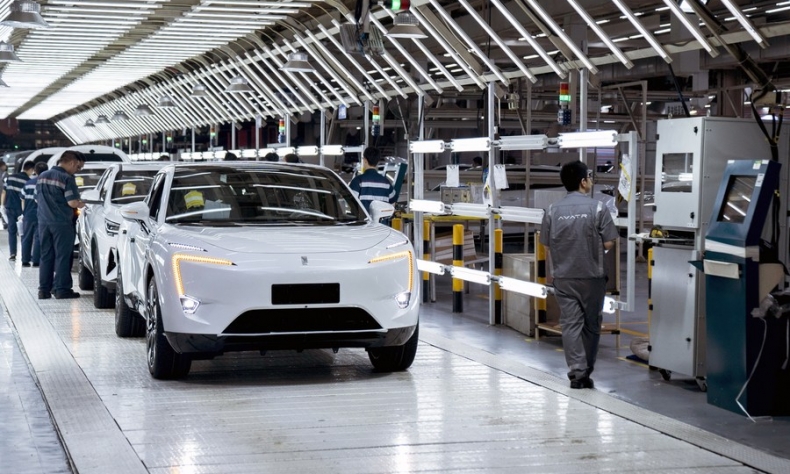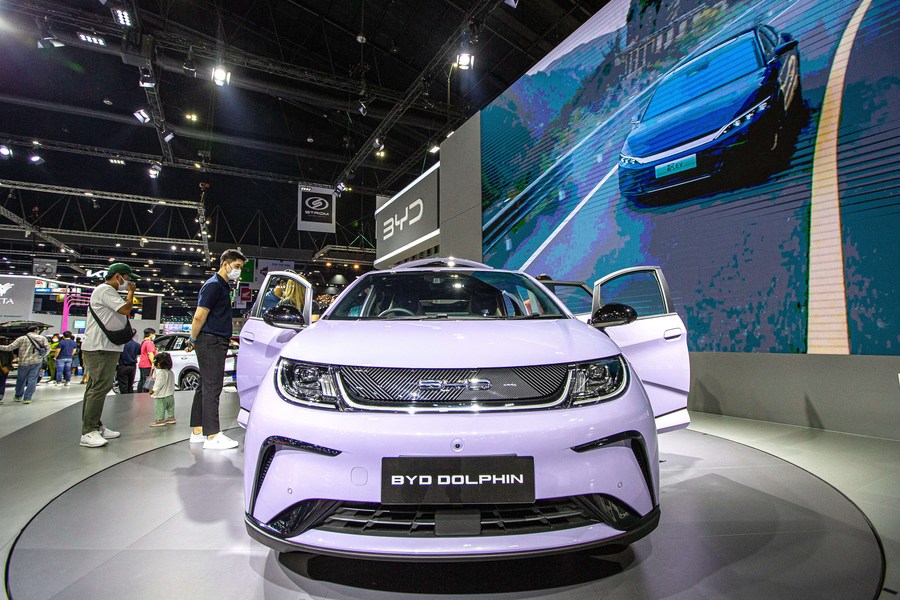In the Fast Lane

With the most complete industrial system, China’s has maintained the world’s strongest manufacturing capability for more than a decade.
China’s crowded and fiercely competitive new energy vehicle (NEV) market has got yet another player. In a closely watched move, tech major Xiaomi launched its first NEV model SU7 on 28 March.
The past years have witnessed many less competitive NEV brands, including some well-known ones, knocked out of the market as well as rounds of price wars among the remaining ones. Doubts had been cast about the auto business prospects of Xiaomi, which is known for its cost-effective smartphones and home appliances such as televisions. But the SU7 sport sedan, the result of three years of development and with a price tag of 215,900 yuan ($30,431) for the standard version, got off to a good start, garnering orders for over 88,000 units in 48 hours after its launch, according to the manufacturer.
The initial success of the late-comer is good news for a rapidly growing NEV market in China. Data from the China Association of Automobile Manufacturers (CAAM) shows that the production and sales volumes of NEVs in China reached 2.12 million units and 2.09 million units in the first quarter of this year, up 28.2 percent and 31.8 percent year on year, respectively.
A booming industry
The SU7 model came with everything today’s NEVs in China must have: long range starting at 700 km, high-voltage electrical architecture for fast charging, autopilot system, as well as convenient interaction with other Xiaomi devices, optional physical buttons and a torch that can also be used to break the windows.
The past years have seen rapid technological advancement in China’s NEV sector, addressing consumer concerns such as battery safety and long charging time. As a result, more people are interested in buying NEVs. In 2023, the penetration rate of NEVs, i.e. proportion of NEVs in total auto sales, reached 31.6 percent in China. NEV sales in China accounted for over 60 percent of the global total in the year.
NEVs made by China are also becoming popular worldwide. The country exported over 1.32 million vehicles in the first quarter of 2024, according to CAAM. NEVs accounted for some 307,000 among them, up 23.8 percent year on year. In March alone, China’s NEV exports soared 59.4 percent from the same period last year.
Market leader BYD, headquartered in Shenzhen, Guangdong Province, has built a formidable position in the industry. On 25 March, its 7 millionth NEV, a model Denza N7 car, rolled off the production line in Jinan, Shandong Province in east China, making it the world’s first automaker to reach such a large NEV output.
BYD’s sales of electrical cars (EVs), NEVs that are powered solely by battery, surpassed those of US EV maker Tesla in the fourth quarter of 2023, ranking first globally for the first time. It also reported annual NEV sales of more than 3.02 million units last year, maintaining its lead in the global market. Its NEVs are exported to 78 countries and regions around the world, and it has built factories in countries including Brazil, Hungary and Thailand.

A conducive environment
The growth of China’s NEV market this year came at a time when the global landscape of the industry is experiencing setbacks, with Apple halting development on its electric car project a decade after its launch, and other major auto makers such as Ford, General Motors and Volkswagen slowing down their EV development.
In a meeting with Chinese EV manufacturers operating in Europe on 7 April, Chinese Minister of Commerce Wang Wentao stressed the role of a well-established supply chain system, as well as constant tech innovations and full market competition, in Chinese EV manufacturers’ rapid development.
With the most complete industrial system, China’s has maintained the world’s strongest manufacturing capability for more than a decade. In the new energy industry, China has a full industrial chain covering material research and development, engineering design, manufacturing and final assembly, forming a number of auto industry clusters.
One notable example is the city of Hefei in Anhui Province, which is home to six vehicle manufacturers including JAC and EV maker Nio. The local industrial chain is strongly linked to the automobile industry, with a high production capacity of display screen, chip, artificial intelligence, battery and other products.
The well-established supply chain system has enabled companies to turn their design into products at favourable costs, so that companies like Xiaomi can develop a new auto brand from scratch in three years.
Supporting infrastructure such as charging facilities is also essential for the growth of China’s NEV sector. According to a report by the China Electric Vehicle Charging Infrastructure Promotion Alliance, with ongoing advancements in NEV and power battery technology, the primary challenge hindering widespread NEV adoption has changed from battery range to charging convenience.
But the construction of such infrastructure is accelerating. Data from the alliance shows that 716,000 new charging piles were erected during the first quarter of 2024, marking a 13.2 percent increase compared to the same period in 2023. By the end of March, the country had more than 9.31 million charging piles, a year-on-year increase of 59.4 percent.
The NEV sector also enjoys strong policy support, as it constitutes an essential part of China’s new energy resources development and carbon reduction endeavours. Most recently, the National Development and Reform Commission and three other authorities released a guideline to strengthen the integration of NEVs into the country’s power grid. By 2030, NEVs will become an important part of the country’s electrochemical energy storage system, according to the guideline. This will help address the instability of new energy resources.
The momentum in the NEV sector has spurred optimism about the prospects of the rising industry. The National Information Centre of China recently predicted that the penetration rate of NEVs would increase to 60 percent by 2033 in the country, higher and faster than the 2020 national target of 50 percent by 2035.
 Facebook
Facebook
 Twitter
Twitter
 Linkedin
Linkedin
 Google +
Google +










